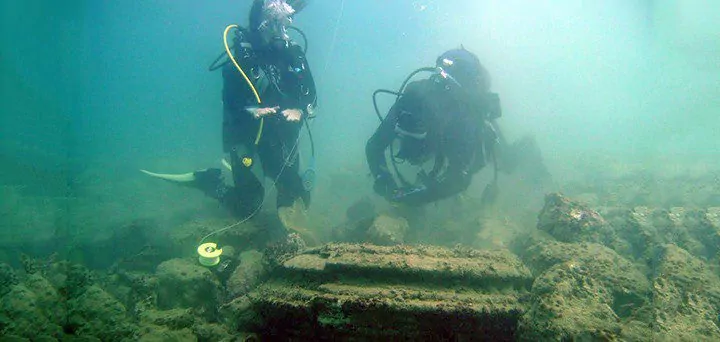It must have seemed obvious – snorkellers off the Greek island of Zakynthos who came across what looked like the cylindrical bases of pillars and stone paving slabs thought they had found the remains of a lost civilisation.

But experts from Greece’s Ephorate of Underwater Antiquities found no signs of man-made artefacts such as pottery, sculpture or coins – and further investigation showed the mysterious structures to have originated millions of years before Hellenic antiquity.
They were in fact created by microbes in a natural process that often occurs way beyond scuba-diving depths but has rarely been documented in shallow water before.
The discovery near Alikanas Bay was investigated by a scientific research team set up by the University of Athens and the University of East Anglia (UEA), which has just published its findings in the journal Marine and Petroleum Geology.
Using microscopy, X-ray and stable isotope techniques, the researchers concluded that the site had been created as much as 5 million years ago, during the Pliocene era, in a process familiar to wreck-divers – concretion.
“We investigated the site, which is between 2 and 5m under water, and found that it is actually a natural geologically occurring phenomenon,” said lead author Professor Julian Andrews of the UEA’s School of Environmental Sciences.
What had initially appeared as perfectly circular column bases were “typical of mineralisation at hydrocarbon seeps”, he said. “The linear distribution of these doughnut-shaped concretions is likely the result of a sub-surface fault which has not fully ruptured the surface of the seabed. The fault allowed gases, particularly methane, to escape from depth.
“Microbes in the sediment use the carbon in methane as fuel. Microbe-driven oxidation of the methane then changes the chemistry of the sediment, forming a kind of natural cement, known to geologists as concretion.”
In this case the “cement” was the mineral dolomite, which rarely forms in sea water but can be found in microbe-rich sediments. The resulting seabed structures were later exposed through erosion. “This kind of phenomenon is quite rare in shallow waters,“ said Prof Andrews. “Most similar discoveries tend to be many hundreds and often thousands of metres deep under water.”
He added that the finding was proof of natural methane seeping out of rock from hydrocarbon reservoirs. “The same thing happens in the North Sea,” he said, “and it is also similar to the effects of fracking, when humans essentially speed up or enhance the phenomena.”
DIVERNET – The Biggest Online Resource for Scuba Divers
03-Jun-16
